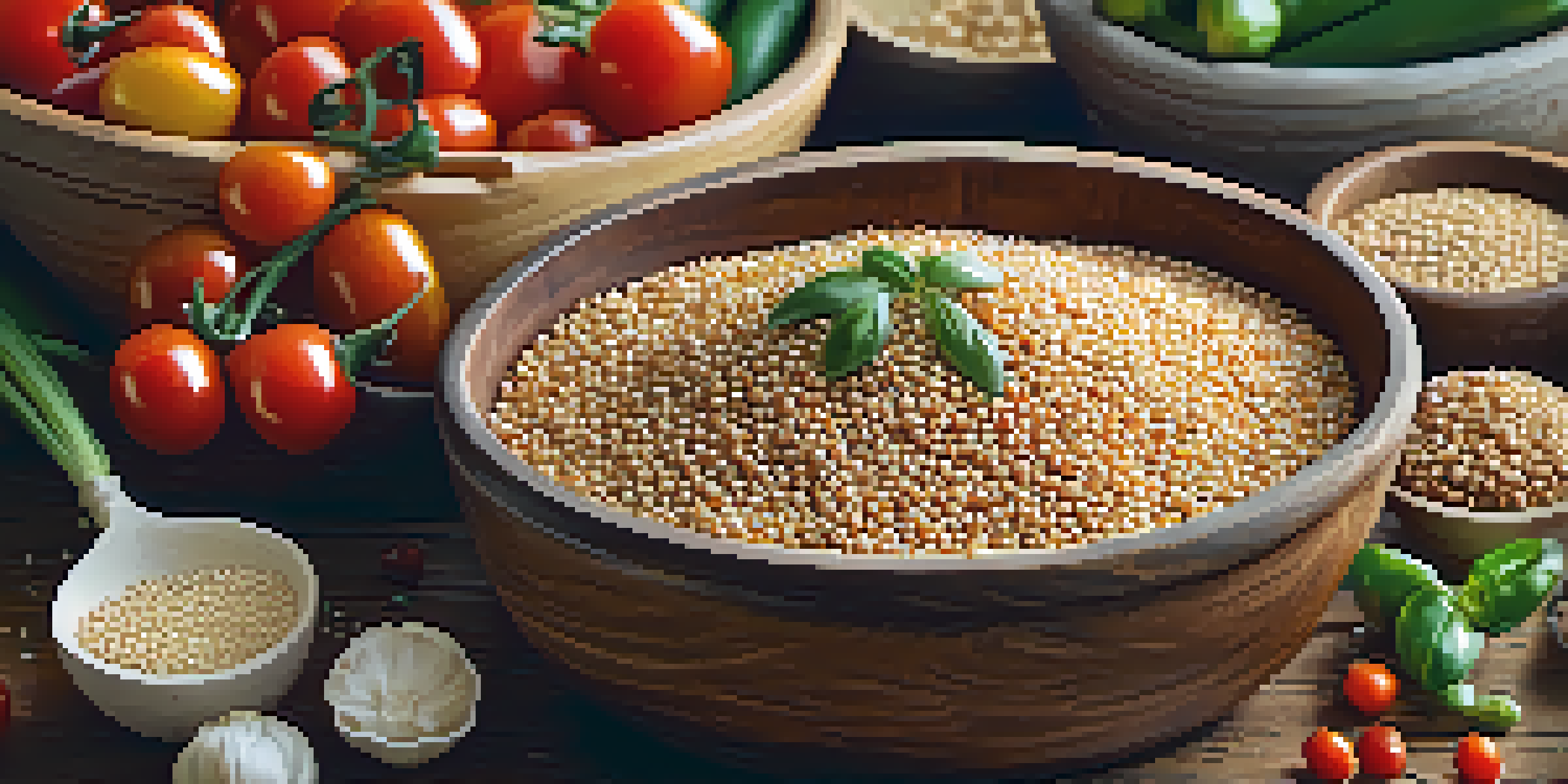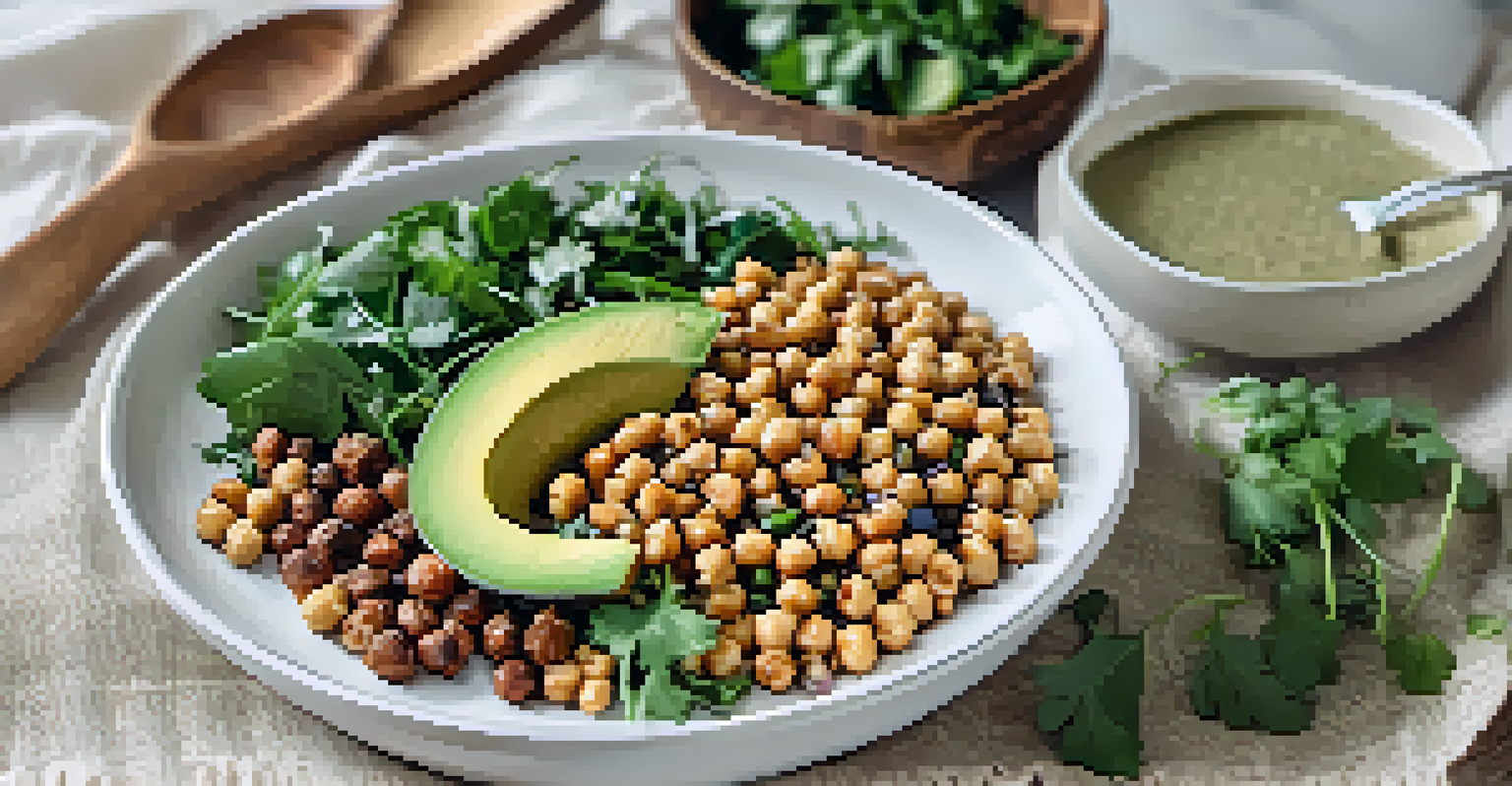Sorghum: A Nutrient-Dense Grain for Vegetarian Diets

What is Sorghum and Why is it Important?
Sorghum is a versatile grain that has been cultivated for thousands of years, especially in Africa and Asia. It's gaining popularity in the West due to its impressive nutritional profile and sustainability. As a gluten-free grain, it serves as an excellent option for those with gluten sensitivities or celiac disease.
Grains like sorghum are essential for a sustainable future, providing nourishment while respecting our planet's resources.
Packed with essential nutrients, sorghum is rich in fiber, protein, and antioxidants, making it a superfood for vegetarians. It’s particularly beneficial in supporting digestive health and providing sustained energy levels. The grain is also low on the glycemic index, which means it won’t cause rapid spikes in blood sugar.
Moreover, sorghum is environmentally friendly, requiring less water and fewer pesticides compared to other grains. This makes it a sustainable choice for both personal health and the planet, aligning with the values of many conscious consumers today.
Nutritional Profile of Sorghum
One cup of cooked sorghum contains approximately 9 grams of protein, 6 grams of fiber, and a wealth of vitamins and minerals. This includes B vitamins, which are vital for energy metabolism, and minerals like iron and magnesium that support various bodily functions. Such a robust nutritional profile makes sorghum an excellent choice for those following a vegetarian diet.

The high fiber content in sorghum not only aids in digestion but also promotes feelings of fullness, which can assist in weight management. Fiber-rich foods are essential in vegetarian diets, as they help to balance blood sugar levels and maintain gut health. This can be particularly beneficial for individuals looking to manage their weight or regulate their blood sugar.
Sorghum: A Nutritional Powerhouse
Sorghum is packed with protein, fiber, and antioxidants, making it an excellent choice for supporting overall health, especially in vegetarian diets.
Furthermore, sorghum is rich in antioxidants such as phenolic compounds, which can help combat oxidative stress and reduce the risk of chronic diseases. Including sorghum in your meals can enhance your overall well-being and provide a protective boost to your health.
How to Cook and Use Sorghum
Cooking sorghum is simple and versatile. You can prepare it similarly to rice or quinoa: just rinse, boil, and simmer until tender. It typically takes about 30-40 minutes to cook, and its chewy texture can add a delightful element to salads, soups, and grain bowls.
Eating a variety of grains can help you achieve a balanced diet, and sorghum is a fantastic addition for its nutrition and versatility.
Sorghum can also be popped like popcorn, which creates a light, crunchy snack. This makes it a fun and innovative option for those looking to diversify their snack choices. You can season popped sorghum with spices or nutritional yeast for an added flavor boost.
Another popular way to incorporate sorghum into your diet is by using it as a flour substitute in baking. Sorghum flour can add a slightly sweet flavor to your baked goods, making it a great choice for pancakes, muffins, and breads. Just remember to combine it with other flours for better texture, especially if you're looking to achieve a light and airy result.
Sorghum in Vegetarian Recipes
Sorghum can shine in a variety of vegetarian recipes, making it easy to incorporate into your meals. For example, you might prepare a sorghum salad with roasted vegetables, herbs, and a zesty dressing. This dish not only tastes great but also provides a colorful presentation and a nutritious punch.
You can also use sorghum as a base for hearty grain bowls, topped with your favorite proteins like chickpeas or lentils, and an array of fresh veggies. This combination offers a well-rounded meal that is both filling and satisfying. Don't forget to drizzle your bowl with a delicious tahini or avocado dressing for an extra layer of flavor.
Sorghum Supports Sustainable Eating
As a drought-resistant grain that requires less water and pesticides, sorghum is an environmentally friendly option that aligns with sustainable agricultural practices.
Sorghum can even be a delightful addition to soups and stews, where it can soak up flavors and add a hearty texture. Simply toss in some cooked sorghum to your favorite recipe for a nutritious boost that complements the dish beautifully.
Health Benefits of Incorporating Sorghum
Incorporating sorghum into your diet can lead to numerous health benefits. Its fiber content promotes digestive health by supporting regularity and preventing constipation. Additionally, the antioxidants found in sorghum can help reduce inflammation and protect against chronic diseases like heart disease and diabetes.
Sorghum's low glycemic index is particularly beneficial for those monitoring their blood sugar levels. By choosing sorghum over refined grains, you can enjoy more stable energy levels and improved metabolic health. This is an important consideration for many vegetarians, especially those who may be inclined to consume more carbohydrates.
Furthermore, the protein content in sorghum makes it a valuable addition to a vegetarian diet, where protein sources may be limited. By including sorghum alongside legumes and nuts, you can ensure you’re getting a well-rounded intake of amino acids, essential for muscle repair and overall health.
Sorghum: A Sustainable Choice
Sorghum stands out as a sustainable grain option, which is a crucial factor for many environmentally-conscious consumers. It requires significantly less water compared to crops like rice and wheat, making it a more efficient choice in areas facing water scarcity. This efficiency means that we can produce more food with fewer resources.
Additionally, sorghum’s resilience to drought and pests reduces the need for chemical pesticides, supporting a healthier ecosystem. As climate change continues to impact agriculture, incorporating more resilient crops like sorghum can help ensure food security for future generations.
Versatile Cooking with Sorghum
Sorghum's chewy texture and adaptability make it a great ingredient for salads, grain bowls, and even baked goods, enhancing various dishes with nutrition and flavor.
By choosing sorghum, you're not just making a healthy choice for yourself; you're also supporting sustainable agricultural practices. This aligns beautifully with the growing movement towards eco-friendly eating and conscious consumerism.
Where to Find Sorghum and Tips for Storage
You can find sorghum in most health food stores or online in various forms, including whole grains, flour, and popped snacks. When purchasing sorghum, look for organic options whenever possible to support sustainable farming practices. This small choice can make a significant impact on both your health and the environment.
When it comes to storage, keep whole sorghum grains in an airtight container in a cool, dry place to maximize freshness. If you have sorghum flour, consider refrigerating it to prevent it from going rancid. Proper storage helps maintain the grain's nutritional quality and flavor.

Finally, don’t hesitate to experiment with sorghum in your kitchen! Whether you’re a seasoned cook or just starting out, this grain can add texture and nutrition to a wide array of dishes. With its versatility, you'll likely find that sorghum becomes a staple in your vegetarian cooking repertoire.